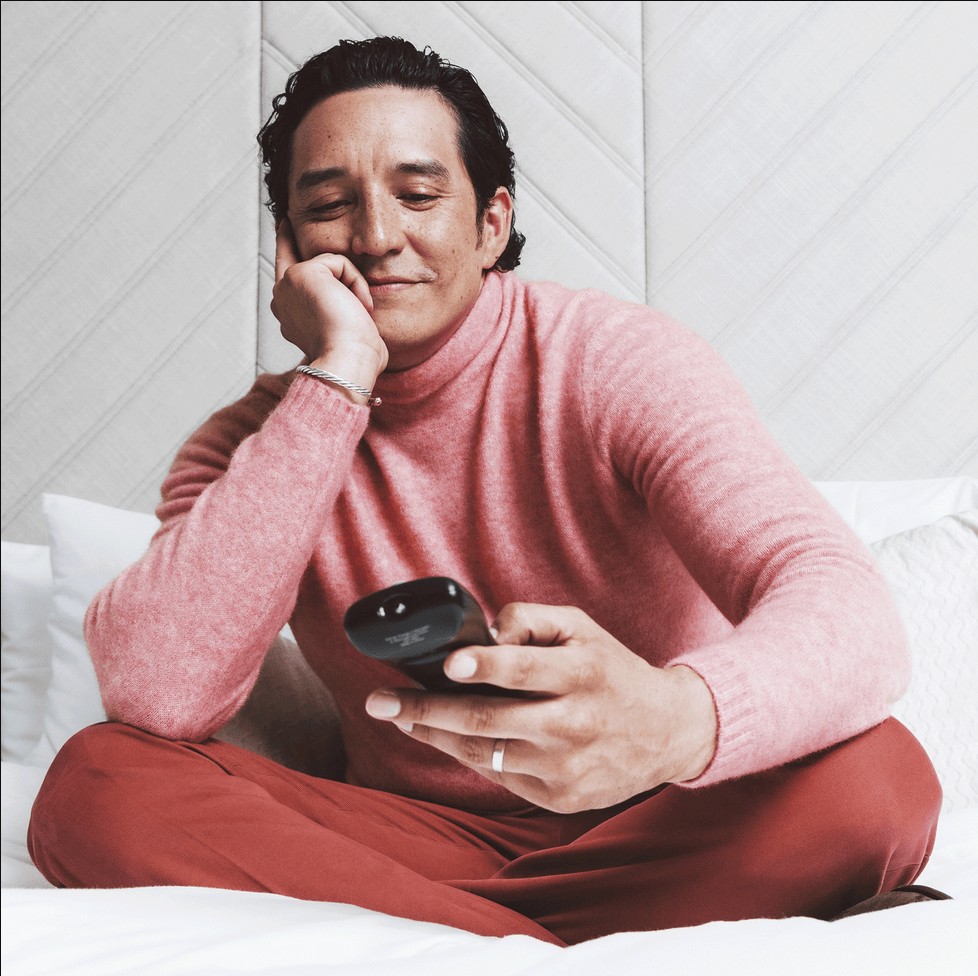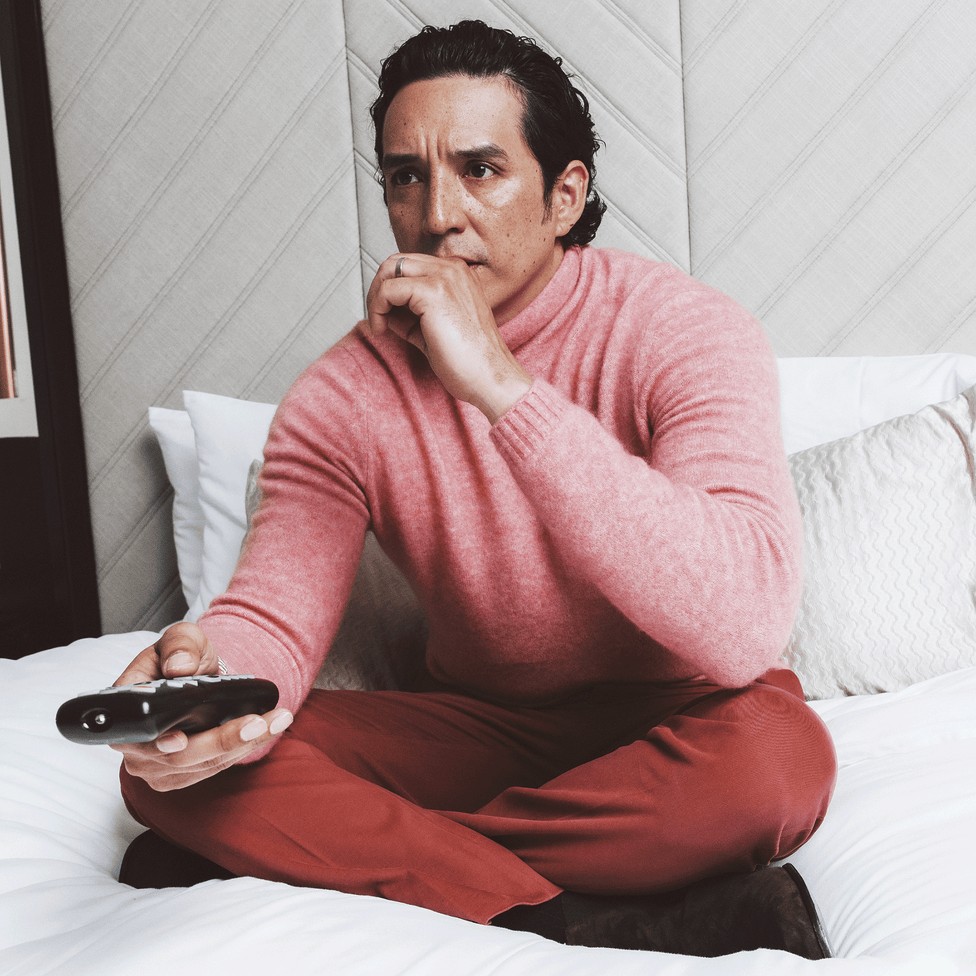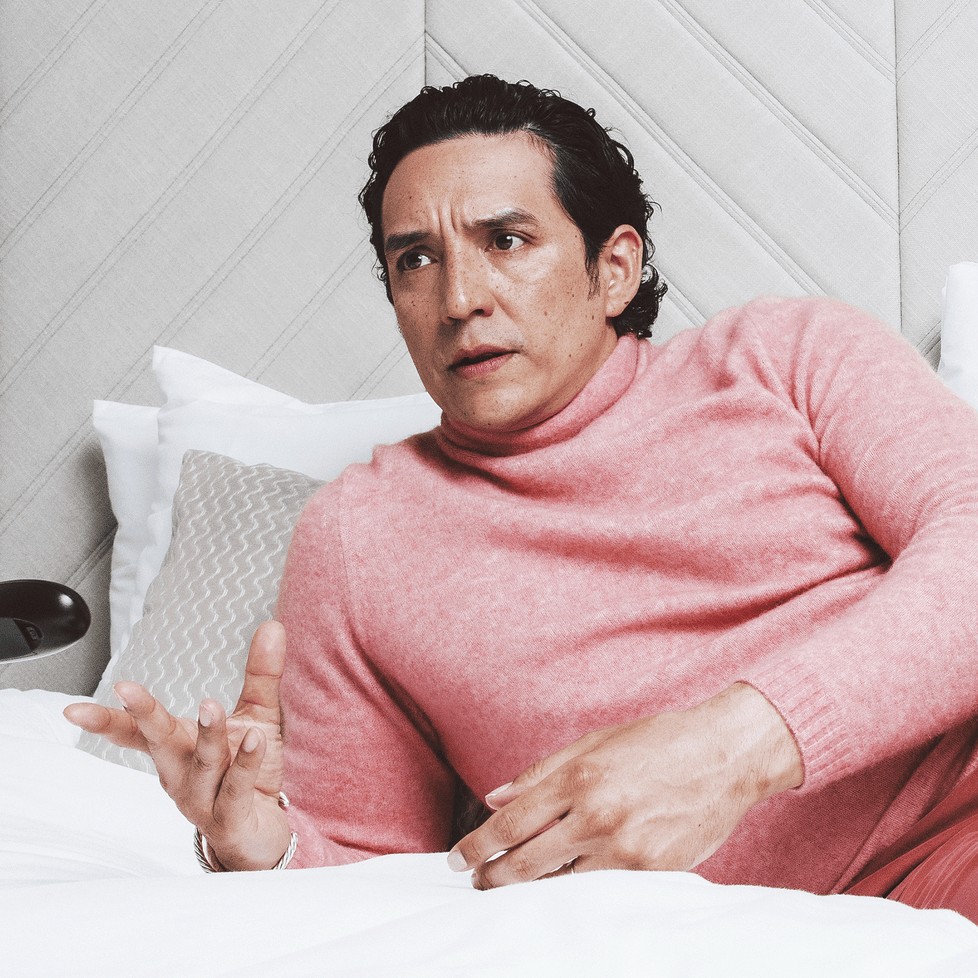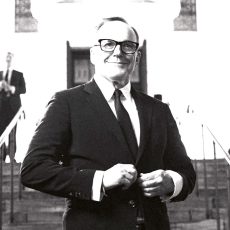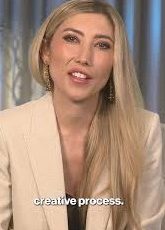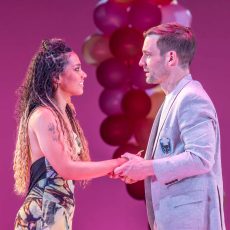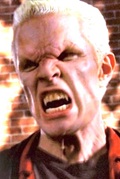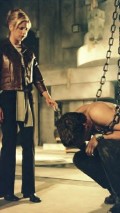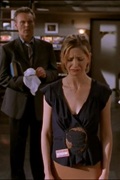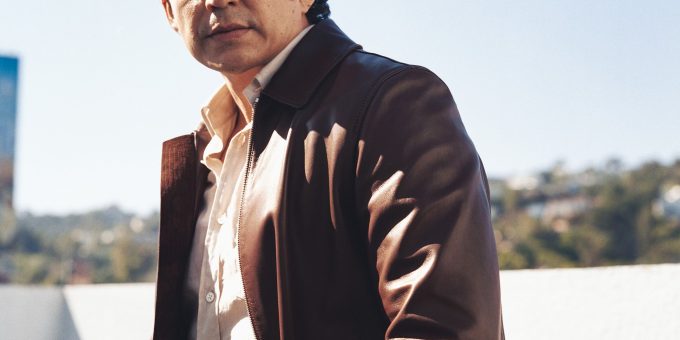
Gabriel Luna Makes The Last of Us Sing

He serenaded the cast on set. He blew up a monster with a flame thrower. And he was just the man to adapt a complicated and conflicted character like Tommy.
GABRIEL LUNA HAS been acting with weapons since 2009, when he went skeet shooting with a 12-gauge shotgun for a little-seen film called Dance with the One. But on the set of HBO’s The Last of Us, he faced a new type of challenge: wielding a flamethrower to take down a giant fungus-infected zombie (called a “Bloater” in the show’s post-apocalyptic reality). “They only gave me three minutes to train on the flame thrower,” Luna says. “There should be some kind of school for that. But it’s really cut and dry – you just point and squeeze.”
To prepare for the scene, which takes place early on in season 2 during a massive battle between an army of infected and a community of survivors based in the Rocky Mountains, Luna watched classic flamethrower scenes from movies like Aliens and Once Upon a Time… in Hollywood. But on the day of the shoot, he had a very different method for getting into character: He picked up his guitar and started to sing. “I remember playing Sly and the Family Stone’s [‘I Want to Take You Higher’] on the day when I was lighting up the Bloater,” Luna says. “I was also strumming the chorus of Jimi Hendrix’s ‘Fire.’ And ‘Ring of Fire’ by Johnny Cash. I did a ‘fire’ medley that day.”
Before The Last of Us, Luna was probably best known to audiences for playing Robbie Reyes (a.k.a. Ghost Rider) in the Marvel show Agents of S.H.I.E.L.D. or as the evil robot Rev-9 in Terminator: Dark Fate. But ever since 2023, he’s become most recognizable as Tommy Miller, the younger brother of Joel (Pedro Pascal) in HBO’s The Last of Us, a grounded adaptation of the critically acclaimed PlayStation games.
While Tommy played only a small part in the show’s first season – the main characters spent more time talking about him that actually talking to him – his role became far more central in The Last of Us‘s second go-around on HBO. But that has also come with some major changes from the video game source material: In the game, Tommy is the first to trek out to Seattle to take revenge on Abby for killing his brother, but in the show, he initially hangs back. For a story that expertly triangulates the ways anger and vengeance can warp a person, this changed the calculus for playing Tommy. “There are many different facets of Tommy that we get to explore,” Luna says. “We get to see the family man, the politician, the councilman, the protector, the lover, the father. He’s becoming more prominent in the story.”
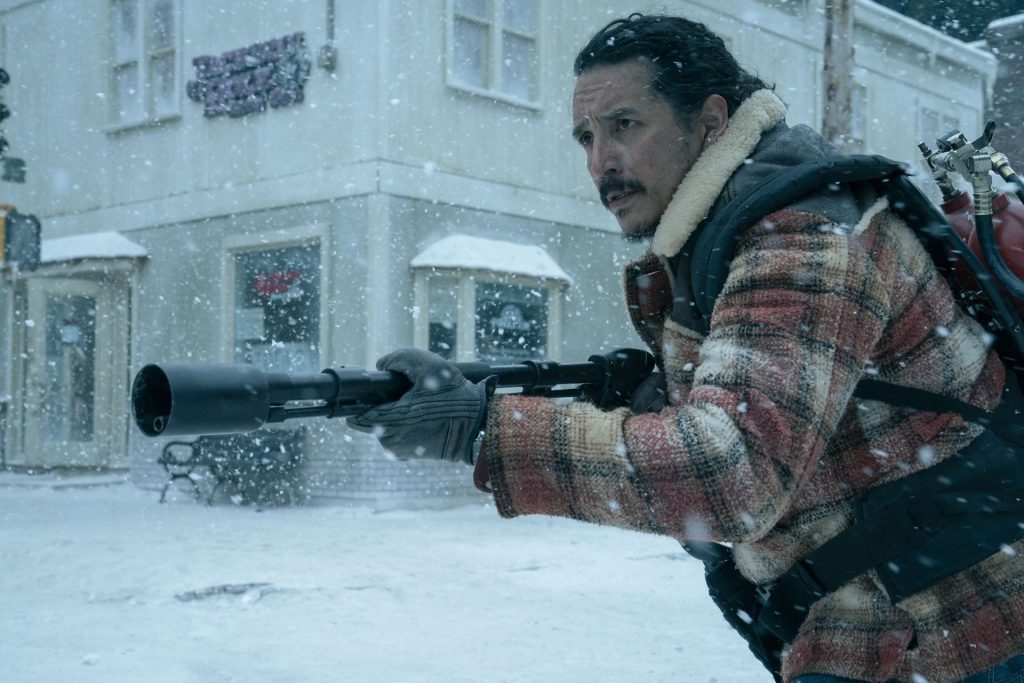
Gabriel Luna wielding a flamethrower in The Last of Us season 2, episode 2.
Like his character, Luna contains multitudes. He’s an action star and a dramatic actor with theatrical training. He’s a careful thinker and a trained sniper. He’s a gamer with a penchant for cool leather jackets. At age 42, he’s still exploring. And now that The Last of Us has aired its season finale, Men’s Health asked Luna to explore the deep – and often dark – themes of the show. He also hints what will come after the episode’s cliffhanger for Tommy and Ellie, traces the changes from the game to the show, and nerds out on the power of video game storytelling.
MEN’S HEALTH: The Last of Us showrunner Craig Mazin recently told us that it’s been a “joy to watch Gabriel blossom on our show.” Now that season 2 is over, do you feel like you, or your character, have blossomed?
GABRIEL LUNA: Well, he’s getting up there in years. So I don’t know if blossom is the right word, but he’s developed. In the first season, they spent quite some time looking for me. Once they found me, it was impactful but brief when Joel and Tommy come together. Now we get to see what they built – and that’s what I was excited to jump into.
MH: Season 2 changes Tommy’s story in a few interesting ways from the game. For starters, you get to lead the defences of Jackson, Wyoming against a massive army of infected. How does that one change impact the rest of the plot?
GL: The change in episode 2 was an approach we arrived at together – Neil [Druckman, creative director of the games and co-creator of the show], Craig, and myself. They went off and wrote this incredible action sequence that balanced the scales between a very intimate and tragic moment and an equally dark and dangerous situation happening back in Jackson. We get to show what there is to lose.
That changes the nature of Tommy’s character. He’s more rooted by his family and his son. But he is drawn, as we find out, to his responsibilities beyond his blood. His love for Ellie is a driving force for him to ride out, hopefully save her, and bring her home. Once he’s in Seattle, he realized how close and within his grasp these people responsible for his brother’s death are. So, it changes things from the game, but it doesn’t.
“It’s really JUST THE BEGINNING of this tale.“
MH: In the game, Tommy is the first one to go after Abby after she kills Joel. But in the show, Ellie and Dina leave first, and Tommy ends up tracking them down. You’ve played the video game – were you preparing for a different type of performance before you got the scripts for season 2?
GL: I don’t know if it changed entirely. The nature of the character is still there. His heart is still there. He’s just a bit more evolved and mature than he would have been in the game. In the game, his wife is with child, but he’s yet to now what being a father really entails. That’s the great thing about doing this adaptation – in the game, as the player goes through their subjective experience, there’s lots to be filled in regarding Tommy as a character. I’m excited for season 3, because there is an opportunity for that.
MH: The Last of Us season 2 ends on a huge cliffhanger, for Tommy in particular. Talk to me about filming that final scene.
GL: We moved into this beautiful theater, the Orpheum in Vancouver, and had this wonderful Sunday where we all just jammed out and got to be in that space. It was remarkably similar to the theater in the game; we didn’t change anything. The color of the seats, the molding, the beautiful fresco – so much unexpected synchronicity.
It’s such a critical turning point. We don’t know what Tommy’s been up to before he finds Ellie. When he arrives at the theater, there is this brief moment where he’s thinking, Am I able to get through to her? Can she make peace with this so that we can all go home together and leave this hate and revenge behind? There’s a moment where, seemingly, we might be going home. Then I go to the lobby, and once again, a lot is unseen. How exactly Abby gets the drop on Tommy is something you find out later in the game when you start to enter different perspectives.
It was intense. I listened to most of the scene as I was being held at gunpoint on the ground, but I wish I could have been watching at the monitor. I would go watch Kaitlyn [Dever] and Bella [Ramsey] in their scene – that standoff is so beautiful. They’re two extremely talented young actors, and we’re very blessed to have them both. They seem to have this kind of ancestral knowledge within them. They’re so young, yet have eons of emotional depth. It was a great day, and it’s just really the beginning of this tale.
MH: In the game, that scene doesn’t get resolved for a while as we flash back to tell Abby’s side of the story, which seems to be the show’s approach too. Have you filmed the rest of that scene?
GL: Well, I really can’t say.
MH: In the game, Tommy plays a pretty dark role as the story nears its conclusion. How are you feeling about that as season 2 comes to a close?
GL: To me, Tommy is this shining light of warmth and humor. He’s the type to tell a joke in the face of death and destruction and try to lift people’s spirits. And at the end of the game, you see how he’s been poisoned by this pursuit of vengeance and by the hatred that eats away at him from the inside. He’s broken physically, mentally, emotionally. He’s strayed so far from the Tommy we’re showing in season 2 right now.
That’s what I love about this story. No one is immune to the weight of the world, and many of them crumble underneath it. We’ll see how the show handles that moving forward. That’s also a true part of life – not everything emerges unscathed. In fact, no one does. Even if they’re still breathing, no one ever really gets out alive. And that’s kind of the way of this story, Neil Druckmann has a very subtle and beautiful perspective on things.
MH: You play guitar, and you’ve said that you like to play different songs to get into character for each scene you film. Can you give me any examples of songs you played ahead of pivotal scenes in season 2?
GL: When we were in Jackson, I remember being up on that hill with Bella. We were in Fortress Mountain, taking Snowcats to the the of the Rockies, and shooting this incredible sniper school scene for Bella. I played “A Thousand Miles from Nowhere” by Dwight Yoakam.
In scenes with Rutina [Wesley, who plays Tommy’s wife, Maria], I played “If Tomorrow Never Comes” by Garth Brooks. The lyrics are: If tomorrow never comes, would she know how much I love her? Did I try in every way to show her that she’s the only one? I think it’s a perfect song for them, because at any point, they could all perish. “I Will Follow You into the Dark” by Death Cab for Cutie is one of Rutina’s favorite songs, so I learned that and played it for her too.
“I give everybody the BENEFIT OF THE DOUBTE until I can’t anymore!”
MH: Empathy plays a major role in The Last of Us. What’s your philosophy when it comes to empathy?
GL: When people ask what the story’s about, I always say it’s about forgiveness and learning forgiveness. It’s about finding your family, but it’s also about losing them. And when they’re lost in such a horrible way, how do you make sense of that? How do you resolve those feelings?
In terms of approaching it with empathy, I think that’s the position we put the audience in. The characters themselves are all empathetic people, but for those they have shared experiences and histories with. There are a lot of people in the world of The Last of Us who are unknown and foreign and can be perceived as monsters. That’s the problem. It’s easy to “other” everyone, and that’s one of the lessons of the game and the show.
For me, I give everybody the benefit of the doubt until I can’t anymore. I’ve learned to recognize when that’s the case, and to protect those around me and move away from situations like that. Empathy also goes in that direction, towards identifying and dealing with threats. So I guess that’s my approach to humans.
MH: I know you’re into clothing. If Gabriel Luna were living in a post-apocalypse, what kind of clothes would you want to be wearing?
GL: I mean, you can’t go wrong with a pair of Levi 501s, or some Wranglers, boot cut. Durable. Functional.
MH: You played Ghost Rider in the Marvel TV show Agents of S.H.I.E.L.D. back in 2016. Almost a decade later, it seems like the MCU is planning on bringing back a lot of characters in the next two Avengers movies. Have you heard anything about a possible return to the role?
GL: I don’t know, what have you heard?

Gabriel Luna with Catherine O’Hara in The Last of Us Season 2
MH: Me? Nothing. I’m just trying to manifest it.
GL: From our lips to the movie gods’ ears. I’m always open to it – I love that character. I took great pride and joy in being the steward of the Ghost Rider legacy. I had put that to bed a few years ago, but with the way things are kind of reforming, anything is possible. All I can do is continue to do my job and keep my body where it needs to be. Should I get that call, there wouldn’t have to be a “studio pump” to get me ready.
MH: Since anything is possible in the multiverse, who would win in a fight between your Ghost Rider (Robbie Reyes) and Nicholas Cage’s Ghost Rider (Johnny Blaze)?
GL: Oh, man, that’s an eternal battle, as far as fights go. But as far as races go, there’s this badass storyline in the comics where Johnny Blaze is the kind of hell, and Robbie has to go down and beat him in a race, with all these other ghost riders and demons. And he wins the race. So, in a fight, it’d probably be an eternal battle, but in a race, I got Robbie all day.
MH: You recently told Esquire that you’re a huge fan of Hideo Kojima’s video games. What’s your favorite one?
GL: Probably Metal Gear Solid
MH: The first one?
GL: No, probably the third one, where the graphics were really starting to get good. I love how much credit he gives the gamer, in terms of their intelligence and their ability and patience to navigate certain things, especially in [his 2019 game] Death Stranding. I was at South by Southwest at the panel for Death Stranding 2, and that’s where I got to meet Kojima-san. We had a little powwow backstage after, and I got to open my heart to him. His imagination is really a one of a one. I can’t wait for Death Stranding 2. We follow each other now on Instagram, which is absolutely mind-blowing to me. Kojima knows who I am! I’d love to do the performance capture and be immortalized in this photorealistic way in one of these games. So while you’re at it, manifest that too.
This interview has been edited for content and clarity.
Original article at Men’s Health.
This article has been reproduced for archive purposes, all rights remain.
